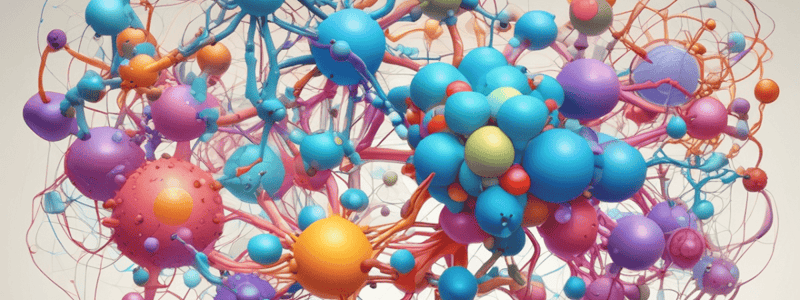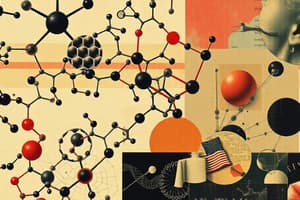Podcast
Questions and Answers
What is the primary source of glucose for the synthesis of starch and cellulose in plants?
What is the primary source of glucose for the synthesis of starch and cellulose in plants?
- Respiration
- Photosynthesis (correct)
- Transpiration
- Plant nutrition
What is the key component of plant cell walls?
What is the key component of plant cell walls?
- Cellulose (correct)
- Semisynthetic polymers
- Proteins
- Starch
What is the main function of proteins in the body?
What is the main function of proteins in the body?
- Storing food
- Regulating hormones
- Providing energy
- Building blocks (correct)
What is the result of acetylation of cellulose with acetic anhydride in the presence of sulphuric acid?
What is the result of acetylation of cellulose with acetic anhydride in the presence of sulphuric acid?
What is the characteristic of cellophane that distinguishes it from plastic sheets?
What is the characteristic of cellophane that distinguishes it from plastic sheets?
What is the composition of Rayon?
What is the composition of Rayon?
What is the primary application of biodegradable polymers?
What is the primary application of biodegradable polymers?
What is the chemical reaction involved in the decomposition of biodegradable polymers?
What is the chemical reaction involved in the decomposition of biodegradable polymers?
What is Polyhydroxy butyrate (PHB) obtained from?
What is Polyhydroxy butyrate (PHB) obtained from?
What is the characteristic of the molecular mass of PHBV?
What is the characteristic of the molecular mass of PHBV?
What is the purpose of biodegradable polymers in agriculture?
What is the purpose of biodegradable polymers in agriculture?
What is the result of the decomposition of biodegradable polymers in the body?
What is the result of the decomposition of biodegradable polymers in the body?
What is the term used to describe the process of converting simple molecules into polymers?
What is the term used to describe the process of converting simple molecules into polymers?
What is the term used to describe polymers that are prepared in a laboratory?
What is the term used to describe polymers that are prepared in a laboratory?
What is the characteristic that distinguishes polymers from macromolecules?
What is the characteristic that distinguishes polymers from macromolecules?
What is the term used to describe the building blocks of polymers?
What is the term used to describe the building blocks of polymers?
What is the classification of polymers based on their source?
What is the classification of polymers based on their source?
What are the polymers that control various life processes in plants and animals?
What are the polymers that control various life processes in plants and animals?
What is the primary reason for thermoplastics becoming brittle over time?
What is the primary reason for thermoplastics becoming brittle over time?
What is the purpose of adding plasticizers to polymers like PVC?
What is the purpose of adding plasticizers to polymers like PVC?
What is the characteristic of low-density polythene that distinguishes it from high-density polythene?
What is the characteristic of low-density polythene that distinguishes it from high-density polythene?
What is the advantage of Neoprene over natural rubber?
What is the advantage of Neoprene over natural rubber?
What is the primary difference between LDPE and HDPE?
What is the primary difference between LDPE and HDPE?
What is the polymerization method used to prepare high-density polythene?
What is the polymerization method used to prepare high-density polythene?
What is the purpose of adding diphenylamine to rubber?
What is the purpose of adding diphenylamine to rubber?
Which polymer is used in the manufacture of automobile mouldings and stronger pipes?
Which polymer is used in the manufacture of automobile mouldings and stronger pipes?
What is the characteristic of Polyvinyl Chloride (PVC) that makes it suitable for use in electrical insulation?
What is the characteristic of Polyvinyl Chloride (PVC) that makes it suitable for use in electrical insulation?
Which polymer is used in the manufacture of non-stick utensils and coatings?
Which polymer is used in the manufacture of non-stick utensils and coatings?
What is the primary application of Polyethylene in the textile industry?
What is the primary application of Polyethylene in the textile industry?
What is the characteristic of Polystyrene that makes it suitable for use in high-temperature applications?
What is the characteristic of Polystyrene that makes it suitable for use in high-temperature applications?
What is the main application of Polyamides like Nylon-66 and Nylon-610?
What is the main application of Polyamides like Nylon-66 and Nylon-610?
What is the characteristic of Polyacrylonitrile (PAN) that makes it suitable for mountaineering ropes?
What is the characteristic of Polyacrylonitrile (PAN) that makes it suitable for mountaineering ropes?
What is the property of thermoplastic polymers that allows them to be dissolved in suitable solvents?
What is the property of thermoplastic polymers that allows them to be dissolved in suitable solvents?
What is the primary application of Polyacrylonitrile (PAN) in textile manufacturing?
What is the primary application of Polyacrylonitrile (PAN) in textile manufacturing?
What is the industrial use of Polyamides like Nylon-6?
What is the industrial use of Polyamides like Nylon-6?
What is the characteristic of thermoplastic polymers that allows them to be reformed and reshaped upon evaporation?
What is the characteristic of thermoplastic polymers that allows them to be reformed and reshaped upon evaporation?
Study Notes
Polymers
- Polymers are compounds of very high molecular masses formed by the combination of a large number of simple molecules.
- All polymers are macromolecules but not all macromolecules are polymers.
Classification of Polymers
- Natural Polymers: obtained from nature (plants and animals), essential for life, e.g., starch, cellulose, proteins, and nucleic acids.
- Synthetic Polymers: prepared in laboratories, e.g., polyethene, PVC, nylon, teflon, bakelite, and synthetic rubber.
- Semi-Synthetic Polymers: derived from naturally occurring polymers by chemical modifications, e.g., cellulose diacetate, rayon, and vulcanized rubber.
Biodegradable Polymers
- Polyhydroxybutyrate (PHB): obtained from hydroxy butyric acid, used in medical goods, agriculture, and personal hygiene products.
- Poly-Hydroxybutyrate-co-β-Hydroxy valerate (PHBV): copolymer of 3-hydroxy butanoic acid and 3-hydroxy pentanoic acid.
Structural Polymers
- Starch: polymer of glucose, food reserve of plants.
- Cellulose: polymer of glucose, chief structural material of plants.
Protein Polymers
- Proteins: polymers of α-amino acids, building blocks of animal body, essential part of food.
Nucleic Acids
- Polymers of nucleotides, e.g., RNA and DNA.
- Control various life processes in plants and animals, also called biopolymers.
Synthetic Polymers
- Polyethylene (Polyethene): thermoplastic, used in packaging, pipes, and bottles.
- Polyvinyl Chloride (PVC): thermoplastic, used in raincoats, handbags, and shower curtains.
- Teflon: thermoplastic, used in non-stick utensils and gaskets.
- Nylon: thermoplastic, used in textiles, ropes, and bearings.
- Polyacrylonitrile (Orlon): thermoplastic, used in clothes, carpets, and preparation of other polymers.
Studying That Suits You
Use AI to generate personalized quizzes and flashcards to suit your learning preferences.
Related Documents
Description
This quiz covers the basics of polymers and biomolecules, including starch, cellulose, and proteins. Learn about their structure, function, and importance in plants and animals.




